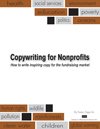There are many reasons why some stories generate more response from readers than others. Jeff Brooks highlights a reason in Future Fundraising Now: The motor neurons in our brain are stimulated by action and intent.
There are scientific instruments that record brain activity. Researchers can “see” what stimulates people the most as they read a story. They can “see” what is most interesting to the reader. They can “see” what creates involvement (more mental activity) as the person reads the story.
Why does this matter to you?
It matters because it helps you write stories that your donors or members will be more likely to respond to. That means you’ll have more success with your fundraising, advocacy, or membership drives.
Many of the best stories include these elements:
- Intent
- Goal-directed action
- People grasping objects
- People moving around
For example . . . Are the characters/people in your stories grabbing their child to save her from a collapsing wall during an earthquake? Are they handing a bowl of piping hot stew to a hungry child in a soup kitchen? Are they determined to learn how to read at age 42 so they can get a better job and provide a better life for their family? Is the member receiving news (or sharing the news with their family) of a promotion after completing a professional development course your association offers?
Great stories paint a vivid picture and involve the reader – mentally and emotionally – with the action taking place. Make the characters in your story come alive and your donors or members will respond. Science and your direct marketing results are the proof.

{ 5 trackbacks }
{ 0 comments… add one now }